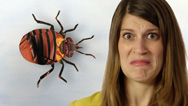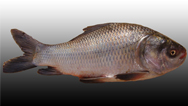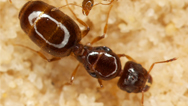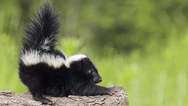The Secret Lives of Reindeer
- By Anna Rothschild
- Posted 12.22.16
- NOVA
Meet the real Rudolph—from bloody antlers to super vision—in this episode of Gross Science.
Transcript
The Secret Lives of Reindeer
Posted: December 22, 2016
It's the holiday season, and this year I was lucky enough to travel up above the Arctic circle where I saw some reindeer. Now, while some magical reindeer may pull Santa's sleigh, your average, everyday reindeer is pretty fascinating, too. So today, let's talk about the bizarre side of reindeer that you may never have known existed.
I'm Anna and this is a Gross Science.
One of the first things I noticed when I saw reindeer this year was that their antlers were bloody. To understand why, you need to know what antlers are. Antlers are bony projections from the skulls of most male deer. But reindeer are the only species of deer in which the females typically grow antlers, too. The antlers start out soft, and are covered in a layer of skin and hair called "velvet." Blood flowing through the velvet can transport lots of oxygen and nutrients to help the antlers grow quickly. However, eventually the antlers harden, and the reindeer will scrape the velvet off—making them look kinda like hangers covered in beef jerky. A few months later, the reindeer will shed their antlers, and grow them anew the next year.
In fact, depending on where Santa gets his reindeer, he might have an all-female sleigh team—or a team made up of castrated males, called steers. Intact male reindeer in many parts of the world will lose their antlers before Christmas, while females and steers will keep theirs longer into winter.
Now, as you know, reindeer live in places with lots of snow. So they have many adaptations to help them survive in this hostile climate. One adaptation is the ability to see UV light, which is outside the spectrum of what humans can see. Snow and ice reflect UV, so to a reindeer, anything that absorbs it will appear black and stand out in the snowy landscape. And it turns out that lichens, which the reindeer eat, and urine and fur, which can be signs of predators, all absorb UV light. We still don’t know how reindeer protect their eyes from UV damage, though. When humans encounter that much UV light, we can experience something called “snow blindness,” which is basically a sunburn on your eyeball.
Reindeer may be very well adapted to their cold environment, but the climate of the Arctic is changing. And a multi-year study in Svalbard has found that global warming may have dire impacts on reindeer populations. As the climate warms, there’s more food available in the summer, which makes females healthier and able to get pregnant more easily. But warmer temperatures in the winter also means that rain falls more frequently on top of the snow. And when it freezes, it forms an icy layer that reindeer can't dig through to get to the plants and lichen that they need to survive the winter months. And that means that there isn't enough food to go around for all the reindeer mothers-to-be. So, mothers have been giving birth to smaller calves, and even terminating their pregnancies if they’re not getting enough food.
Climate change would not only be a problem for these animals, but also for the people who rely on them. Various northern indigenous groups have domesticated these animals, and used for transportation, milk, meat, and fur. And they’re still important for many people’s livelihood today. So we shouldn't just think about reindeer over the holidays. We should do what we can to protect them all year round.
Ew.
Hey everyone—one additional fact! Caribou are technically the same species as reindeer. But in North America we call wild animals “caribou” and domesticated animals “reindeer.” The two can mate, but they do behave differently and have some physiological differences, as well. In Europe, however, wild animals in places like Svalbard are called “reindeer” and not “caribou.”
Credits
PRODUCTION CREDITS
- Host, Writer, Animator, Editor
- Anna Rothschild
- Camera
- Jeffrey Wood
- Snowflake Waltz a
- Tinker Belles b
- Sugar Plums b
- Music Provided by APM
- Original Footage
- ©WGBH Educational Foundation 2106
FOOTAGE AND IMAGES
- Male Svalbard reindeer (Rangifer tarandus platyrhynchus) shedding the velvet from its antlers, Spitsbergen, Svalbard, Norway, September
- Roy Mangersnes/Nature Picture Library
- Santa Claus rides in a reindeer sleigh. He hastens to give gifts before Christmas. This is fast team of eight deer.
- Shutterstock/Vladimir Melnikov
- reindeer in velvet roaming in lush green arctic svalbard meadow
- Shutterstock/FloridaStock
- full grown shaggy Reindeer with peeling shedding velvet on antlers
- Shutterstock/paolo airenti
- Caribou group on pastures in the mountains of Kamchatka in Russia
- Shutterstock/Sergey Krasnoshchokov
- 20070818-0001-strolling reindeer
- Wikimedia Commons/Alexandre Buisse
- OSHA radiation spectrum
- Wikimedia Commons/OSHA Safety and Health Topics
- Norway on the globe (Svalbard special) (Europe centered)
- Wikimedia Commons/TUBS
- White Baby Reindeer
- Flickr/Heather Sunderland
- Sami people north of Arctic Circle, Norway
- Wikimedia Commons/Preus museum
- Sami village in Kanadaskogen (4502615016)
- Wikimedia Commons/Bergen Public Library Norway
- Sørsame (8220918846)
- Wikimedia Commons/Kommunikasjonsavdelingen NTFK
- Sami People with a reindeer
- Wikimedia Commons/(WT-en) JensANDMarian
SFX
- Cockroaches
-
Freesound/StateAardvark
(used with permission from author) - Squeak Pack/squeak_10
- Freesound/Corsica_S
- Pencil
- Freesound/fastson
- Jelly Mangling on Plate
- Freesound/lolamadeus
- Jawharp Boing
- Freesound/plingativator
- Projector Screen Pull In Out
- Freesound/yoh
- Candy wrapper crinkle b
- Freesound/volivieri
- Dog Howl 01
- Freesound/cgeffex
- Basket creak
- Freesound/sheepfilms
- Produced by WGBH for PBS Digital Studios
Sources
Want more info?
Paper on reindeer seeing UV light:
http://bit.ly/2i1EfOx
Mother Jones on reindeer size and climate change:
http://bit.ly/2i1KBNL
Info on people who herd reindeer around the world:
http://reindeerherding.org
Reindeer’s IUCN Status:
https://www.iucn.org/content/reindeer-not-just-christmas-0
Related Links
-

Gross Science
Bizarre stories from the slimy, smelly, creepy world of science.
-

Power From Fish Scales?
What should you do with stinky old fish skins? How about powering your cellphone?
-

What Does an Ant Sound Like?
Ant language sounds wacky—and can be hacked.
-

The Chemistry of Skunk Spray
How do you get rid of skunk odor? Don't use tomato juice... use chemistry!

